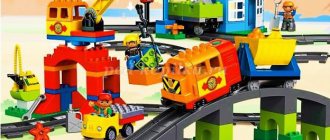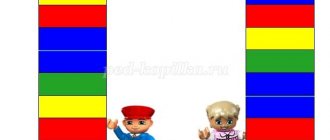Alternative opinion
There are teachers who criticize various aspects of playing with Lego: strict geometric shapes, limited expression of imagination when playing with modern sets, the formation of simplified ideas about objects. Let's figure out whether there is a real danger in playing with construction sets.
Speaking about simplification, it should be noted that you need to choose a construction set and the rules of playing with it in accordance with the age of the child. Any toy will contribute to the development of a child only if the child does not succeed in everything the first time. Sometimes kids themselves try to create more and more complex models; sometimes a timely question asked by an adult can help. Children grow out of their toys, and this is a sign of their development, and Lego allows you to increase complexity by purchasing new sets or changing the goals of the game.
Speaking about limiting the possibilities for expressing imagination, it is necessary to mention that today the choice of designers is quite wide. Some kits are really more suited to building a specific pattern, while more general kits offer more scope for creativity, and mixing different kits can lead to very creative solutions. Paying attention to your child's needs allows you to choose the set that best suits your child.
Critics often mention the unrealistic shapes in Lego sets. Indeed, if a child plays only with Lego all his life, he may not recognize a cat in a living cat. Fortunately, in reality, a child encounters a huge number of images of varying detail, which, on the contrary, enriches the child’s understanding of the variety of objects and phenomena of this world.
The Lego constructor, used consciously by parents, has many advantages, and the disadvantages are often associated not with the set itself, but with the ways of its use and the inadequacy of the child’s age. A construction set cannot replace all of a child’s other toys, but its rational use has a positive impact on the baby’s development.
Conclusion
Construction sets are an excellent educational toy for children of different ages. Modern kits provide a wide range of ways to play: from creating a simple model according to a diagram to designing and creating radio-controlled robots with your own hands. Classes with construction toys develop spatial and logical thinking, voluntary attention, speech and communication abilities of children, teach them to plan their activities and control the process of completing tasks, and develop their personal qualities. Different ways of organizing children's play involve different areas of their development, and the use of construction sets as educational material makes playing with construction sets an element of learning to read and count.
What are the benefits of Lego constructors for a child?
Undoubtedly, construction contributes to the development of children, so let’s figure out in which areas children’s development comes first.
Lego helps develop fine motor skills
Connecting and disconnecting parts of different sizes and shapes requires efforts from the child that vary in direction, strength and duration, thereby perfectly training the hand, preparing it for writing, and also contributing to the development of the baby’s thinking.
Lego develops creativity and out-of-the-box thinking
By inventing their own models, children learn to combine parts of different shapes, colors and sizes. By playing with Lego on their own, kids can create a variety of models, from a farmer's house to an alien spaceship. At the same time, children have almost no restrictions on the type and design of models, which means they have no fear of doing something wrong. It is these conditions that create the atmosphere for the development of imagination and creativity.
Lego develops attention, planning and problem solving skills
By creating models, children learn to plan their activities, find and solve problems, and develop voluntary attention. When creating a model according to instructions, the child learns to read diagrams, break the task into steps and monitor their implementation. When faced with a problem, the child has to double-check the previous steps and analyze where the mistake was made. All these skills will be useful to your child more than once at school and in adulthood.
Lego develops spatial and logical thinking
By creating models independently and according to a diagram, as well as with the participation of adults, the baby gradually becomes familiar with the concepts of color, size, shape, symmetry and balance and constantly has the opportunity to use this knowledge: the designer will stand only if it has legs of the same length, two small blocks can be replaced by one large one; the small base area makes the structure unstable. All these and many other discoveries allow the child to lay a solid foundation for subsequent learning in mathematics and physics, and also forms cognitive motivation.
Lego promotes child speech development
By playing with a construction set in the company of peers or an adult, a child learns to explain his ideas, describe the construction process and the difficulties encountered along the way. The child’s vocabulary is expanded by discussing models: for example, the child discovers that the front of the car has a hood, the place where gasoline is poured is called the fuel tank, and the driver can put things in the trunk. Using different stories and a strong desire to share his ideas, the child, without noticing it, begins to use more and more new words and expressions.
Lego develops teamwork skills
Letting your little one play with building blocks with other children gives him the opportunity to improve his teamwork skills. If there is to be a joint design, you must first decide what it will be, a rocket, a spaceship or a racing car. By creating models together, children learn leadership and cooperation, assign roles and use different ideas to create more interesting games. Kids learn to subordinate their actions to a common idea, create and accept the rules of the game, explain their ideas, assign roles, set aside their opinions and accept amendments to the original plan.
The ability to organize interesting teamwork with the help of construction toys even prompted American psychologists to introduce a new direction of therapy, called Lego therapy, designed to help children with communication difficulties learn to interact with peers. During Lego therapy, children create models with the support of a child psychologist who helps children set goals, assign roles and achieve results together.
Lego develops determination and strengthens a child's self-esteem
When playing with Lego, children tend to build more and more complex structures. Such models require not only developed planning skills, but determination to achieve the goal. When encountering difficulties, a child can rebuild the model almost from scratch, but the reward in the form of a result will not be long in coming. The Lego set is designed in such a way that external factors have almost no effect on the final result - the parts rarely break and always fit together. Thanks to this, the child always gets results in accordance with the efforts made, which has a positive effect on his self-esteem.
Playing with construction sets has a positive impact on the development of a child’s physical, intellectual and communication abilities. Different ways of organizing the game allow you to pay attention to different areas of the child’s development: teamwork develops the child’s communication skills, creating a complex model develops patience and perseverance, step-by-step construction develops the child’s ability to plan and organize independent activities.
Unconventional ideas
The versatility of the construction set's elements allows it to go beyond the playing area. There are many non-standard ideas for using Lego for the development and organization of children's leisure time.
Lego household items
Armed with a search engine, you can find many ideas for creating night lights, key holders, bird feeders and pencil holders from Lego. Together with your child, you can create a gift project for relatives, make a glass for storing pencils according to your own design, or use your imagination to solve the current problem of organizing space at home.
Using a construction set for such purposes has a number of advantages: it is difficult to break, a child can easily correct any mistakes on his own, the item can be disassembled at any time, and the construction set itself does not get dirty and does not require special storage conditions.
Constructors in training
Recently, more and more teachers are using construction sets as visual material when teaching writing and reading, developing the child’s thinking, memory and attention. Addition and subtraction, multiplication and division are explained more easily when using blocks of different sizes. The letters printed on the blocks make learning to read a truly entertaining process. Working with the constructor, the child connects physical activity to the learning process, which makes this process much more effective and interesting. Here is one example of educational games made from Lego:
Creating new tasks is limited only by your imagination, and new ideas can always be gleaned from teachers and parents whose approaches you trust.
Construction sets can become not only an excellent toy, but also educational and creative material for preschoolers and primary schoolchildren. Varying ideas and elements creates almost unlimited possibilities for organizing educational activities for children.






